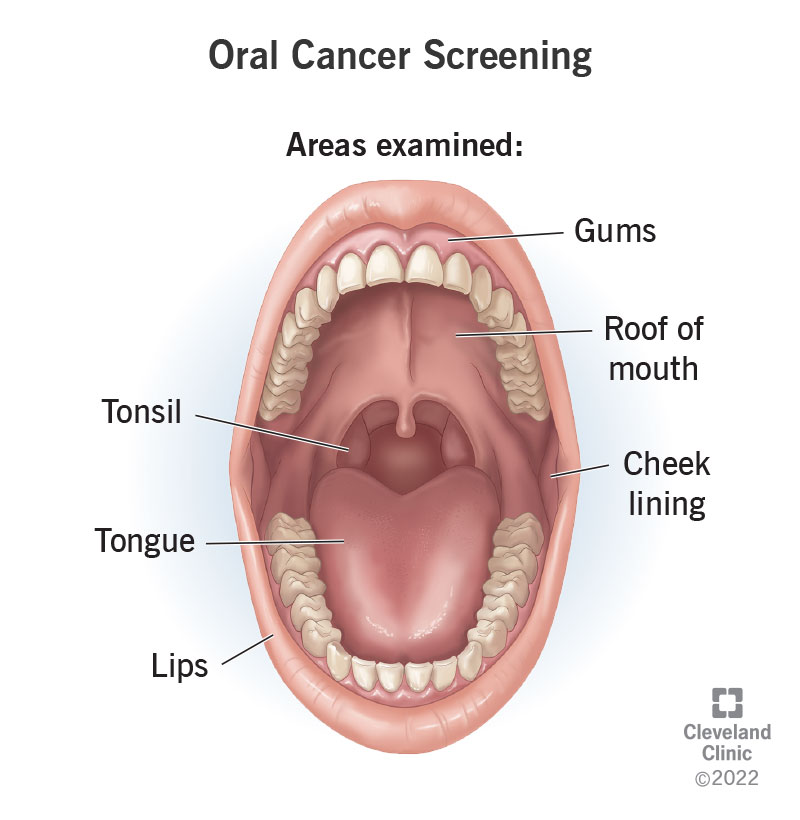Oral cancer screenings help healthcare providers look for signs of cancer in your mouth. They’ll examine the lining of your cheeks, gums, lips, tongue, and floor and roof of your mouth to check for lesions and abnormalities. If they find anything suspicious, they’ll refer you to an oncologist for further testing.
Advertisement
Cleveland Clinic is a non-profit academic medical center. Advertising on our site helps support our mission. We do not endorse non-Cleveland Clinic products or services. Policy
An oral cancer screening is an exam to look for signs of cancer in your mouth. Oral cancers include mouth cancer, jaw cancer and tongue cancer.
Advertisement
Cleveland Clinic is a non-profit academic medical center. Advertising on our site helps support our mission. We do not endorse non-Cleveland Clinic products or services. Policy
The areas examined during an oral cancer screening include:
Oral cancer is a common cancer of the head and neck, affecting people all around the world. Nearly 54,000 Americans receive an oral or oropharyngeal cancer diagnosis each year.
Oral cancer has a five-year survival rate of 57%. This means that just a little more than half of the people diagnosed with oral cancer are alive five years after their diagnosis. Oral cancer isn’t particularly difficult to diagnose. But fatality rates are high because oral cancer is too often detected late in its development. Oral cancer screenings are the best tool available for early diagnosis and treatment.
Healthcare providers use oral cancer screenings to find cancer before symptoms develop. When providers detect oral cancer in its early stages, treatment may be more successful.
While a variety of healthcare providers can perform oral cancer screenings, dentists commonly offer them as part of their routine exams. It’s important to note, though, that oral cancer screenings don’t diagnose cancer. Healthcare providers use screenings to look for signs of cancer. If your provider finds anything suspicious, they’ll refer you to an oncologist for further testing, diagnosis and treatment.
Advertisement
Oral cancer screenings can help detect early signs of oral cancer. But the only surefire way to find out if you have oral cancer is to collect suspicious cells and test them in a laboratory. If your healthcare provider suspects oral cancer, then they’ll refer you to another specialist for evaluation.

There’s nothing you need to do to prepare for an oral cancer screening. The exam usually takes place during a routine dental or physical checkup.
Your healthcare provider may use a combination of oral cancer screening methods, including a visual exam, palpation, and oral screening dyes and lights. They may also take photos of any abnormal areas so they can monitor them. In general, screenings take less than five minutes.
During this portion of the exam, your healthcare provider will look for lesions (areas of abnormal tissue) in your mouth and throat. These abnormalities may include leukoplakia (thick white patches) and erythroplakia (abnormally red areas).
Your healthcare provider will also use their fingers to feel (palpate) for lumps or bumps around your face, neck and jaw. Be sure to let them know if you have areas that are sore or tender.
Many healthcare providers use oral cancer screening tools — like toluidine blue dye — to look for signs of oral cancer. They’ll coat any lesions with the dye, which can help identify areas that are likely to become cancerous.
There are also special lights that can help identify abnormal tissues in your mouth. To use this tool, your healthcare provider will ask you to rinse your mouth with a fluorescent mouthwash. Next, they’ll shine a special light in your mouth, which makes healthy tissue look dark and abnormal tissue look white.
As mentioned above, screenings look for signs of cancer. But you’ll need more testing to get an official diagnosis.
After your oral cancer screening, your healthcare provider will share their findings with you. If the screening indicates that cancer could be present, your provider will refer you to a specialist for further assessment. Tests may include:
Your healthcare provider may also recommend a follow-up visit in a week or so to see if the lesion has changed or healed on its own.
Your healthcare provider can share their findings with you immediately after your oral cancer screening.
Advertisement
If you undergo more testing — such as a biopsy — it typically takes three to five days to get your results.
If you develop mouth pain or notice any new lumps, bumps or lesions, call your healthcare provider right away. Early detection is key, so if you think something isn’t quite right, don’t wait to seek medical care.
Some healthcare providers recommend screening yourself at home for oral cancer once a month. However, a self oral cancer screening isn’t a substitute for bi-annual screenings at your healthcare provider’s office.
Ask your provider how to perform a screening at home. Here are some general guidelines:
Advertisement
A lump found in the neck can be a sign of advanced oral cancer, so feeling your neck for masses or swelling is important. Make note of anything questionable and call your healthcare provider for further instructions.
Oral cancer is a common cancer affecting the head and neck. With frighteningly high fatality rates, early detection is the key for timely diagnosis and treatment. Routine screenings give you the best chance for finding oral cancer in its early stages. Ask your healthcare provider how often you should undergo screenings for optimal health.
Advertisement
When you learn you may have oral cancer, you’ll want the best care. Cleveland Clinic’s head and neck cancer experts offer personalized treatment and support.

Last reviewed on 08/09/2022.
Learn more about the Health Library and our editorial process.